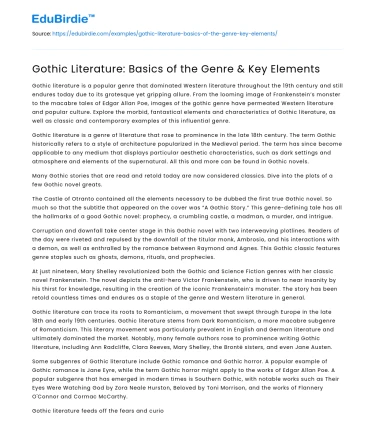Gothic literature is a popular genre that dominated Western literature throughout the 19th century and still endures today due to its grotesque yet gripping allure. From the looming image of Frankenstein’s monster to the macabre tales of Edgar Allan Poe, images of the gothic genre have permeated Western literature and popular culture. Explore the morbid, fantastical elements and characteristics of Gothic literature, as well as classic and contemporary examples of this influential genre.
Gothic literature is a genre of literature that rose to prominence in the late 18th century. The term Gothic historically refers to a style of architecture popularized in the Medieval period. The term has since become applicable to any medium that displays particular aesthetic characteristics, such as dark settings and atmosphere and elements of the supernatural. All this and more can be found in Gothic novels.
Save your time!
We can take care of your essay
- Proper editing and formatting
- Free revision, title page, and bibliography
- Flexible prices and money-back guarantee
Many Gothic stories that are read and retold today are now considered classics. Dive into the plots of a few Gothic novel greats.
The Castle of Otranto contained all the elements necessary to be dubbed the first true Gothic novel. So much so that the subtitle that appeared on the cover was “A Gothic Story.” This genre-defining tale has all the hallmarks of a good Gothic novel: prophecy, a crumbling castle, a madman, a murder, and intrigue.
Corruption and downfall take center stage in this Gothic novel with two interweaving plotlines. Readers of the day were riveted and repulsed by the downfall of the titular monk, Ambrosio, and his interactions with a demon, as well as enthralled by the romance between Raymond and Agnes. This Gothic classic features genre staples such as ghosts, demons, rituals, and prophecies.
At just nineteen, Mary Shelley revolutionized both the Gothic and Science Fiction genres with her classic novel Frankenstein. The novel depicts the anti-hero Victor Frankenstein, who is driven to near insanity by his thirst for knowledge, resulting in the creation of the iconic Frankenstein’s monster. The story has been retold countless times and endures as a staple of the genre and Western literature in general.
Gothic literature can trace its roots to Romanticism, a movement that swept through Europe in the late 18th and early 19th centuries. Gothic literature stems from Dark Romanticism, a more macabre subgenre of Romanticism. This literary movement was particularly prevalent in English and German literature and ultimately dominated the market. Notably, many female authors rose to prominence writing Gothic literature, including Ann Radcliffe, Clara Reeves, Mary Shelley, the Brontë sisters, and even Jane Austen.
Some subgenres of Gothic literature include Gothic romance and Gothic horror. A popular example of Gothic romance is Jane Eyre, while the term Gothic horror might apply to the works of Edgar Allan Poe. A popular subgenre that has emerged in modern times is Southern Gothic, with notable works such as Their Eyes Were Watching God by Zora Neale Hurston, Beloved by Toni Morrison, and the works of Flannery O'Connor and Cormac McCarthy.
Gothic literature feeds off the fears and curiosities of the human experience to weave thrilling, imaginative tales. Keep your journey into literature going by exploring different literary genres, including ghost and monster stories.






 Stuck on your essay?
Stuck on your essay?

